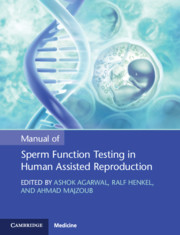Book contents
- Manual of Sperm Function Testing in Human Assisted Reproduction
- Cambridge Laboratory Manuals in Assisted Reproductive Technology
- Manual of Sperm Function Testing in Human Assisted Reproduction
- Copyright page
- Dedication
- Contents
- Contributors
- Short Biography
- Foreword
- Preface
- Introduction
- Chapter 1 Standard Semen Examination: Manual Semen Analysis
- Chapter 2 Standard Semen Analysis: Computer-Assisted Semen Analysis
- Chapter 3 Standard Semen Analysis: Home Sperm Testing
- Chapter 4 Standard Semen Analysis: Leukocytospermia
- Chapter 5 Standard Semen Analysis: Morphology
- Chapter 6 Sperm Vitality: Eosin-Nigrosin Dye Exclusion
- Chapter 7 Sperm Vitality: Hypo-Osmotic Swelling Test
- Chapter 8 Determination of Mitochondrial Membrane Potential by Flow Cytometry in Human Sperm Cells
- Chapter 9 Capacitation and Acrosome Reaction: Fluorescence Techniques to Determine Acrosome Reaction
- Chapter 10 Capacitation and Acrosome Reaction: Histochemical Techniques to Determine Acrosome Reaction
- Chapter 11 Zona Binding: Competitive Sperm-Binding Assay
- Chapter 12 Zona Binding: Hemizona Assay
- Chapter 13 Oolemma Binding: Sperm Penetration Assay
- Chapter 14 Oxidative Stress Testing: Direct Tests
- Chapter 15 Oxidative Stress Testing: Indirect Tests
- Chapter 16 Chromatin Condensation: Aniline Blue Stain
- Chapter 17 Chromatin Condensation: Chromomycin A3 (CMA3) Stain
- Chapter 18 Sperm Chromatin Structure: Toluidine Blue Staining
- Chapter 19 DNA Damage: TdT-Mediated dUTP Nick-End-Labelling Assay
- Chapter 20 DNA Damage: Sperm Chromatin Structure Assay
- Chapter 21 DNA Damage: COMET Assay
- Chapter 22 DNA Damage: Halo Sperm Test
- Chapter 23 DNA Damage: Fluorescent In-Situ Hybridization
- Chapter 24 Clinical Value of Sperm Function Tests
- Chapter 25 Future Developments: Sperm Proteomics
- Conclusion
- Index
- References
Chapter 10 - Capacitation and Acrosome Reaction: Histochemical Techniques to Determine Acrosome Reaction
Published online by Cambridge University Press: 05 April 2021
- Manual of Sperm Function Testing in Human Assisted Reproduction
- Cambridge Laboratory Manuals in Assisted Reproductive Technology
- Manual of Sperm Function Testing in Human Assisted Reproduction
- Copyright page
- Dedication
- Contents
- Contributors
- Short Biography
- Foreword
- Preface
- Introduction
- Chapter 1 Standard Semen Examination: Manual Semen Analysis
- Chapter 2 Standard Semen Analysis: Computer-Assisted Semen Analysis
- Chapter 3 Standard Semen Analysis: Home Sperm Testing
- Chapter 4 Standard Semen Analysis: Leukocytospermia
- Chapter 5 Standard Semen Analysis: Morphology
- Chapter 6 Sperm Vitality: Eosin-Nigrosin Dye Exclusion
- Chapter 7 Sperm Vitality: Hypo-Osmotic Swelling Test
- Chapter 8 Determination of Mitochondrial Membrane Potential by Flow Cytometry in Human Sperm Cells
- Chapter 9 Capacitation and Acrosome Reaction: Fluorescence Techniques to Determine Acrosome Reaction
- Chapter 10 Capacitation and Acrosome Reaction: Histochemical Techniques to Determine Acrosome Reaction
- Chapter 11 Zona Binding: Competitive Sperm-Binding Assay
- Chapter 12 Zona Binding: Hemizona Assay
- Chapter 13 Oolemma Binding: Sperm Penetration Assay
- Chapter 14 Oxidative Stress Testing: Direct Tests
- Chapter 15 Oxidative Stress Testing: Indirect Tests
- Chapter 16 Chromatin Condensation: Aniline Blue Stain
- Chapter 17 Chromatin Condensation: Chromomycin A3 (CMA3) Stain
- Chapter 18 Sperm Chromatin Structure: Toluidine Blue Staining
- Chapter 19 DNA Damage: TdT-Mediated dUTP Nick-End-Labelling Assay
- Chapter 20 DNA Damage: Sperm Chromatin Structure Assay
- Chapter 21 DNA Damage: COMET Assay
- Chapter 22 DNA Damage: Halo Sperm Test
- Chapter 23 DNA Damage: Fluorescent In-Situ Hybridization
- Chapter 24 Clinical Value of Sperm Function Tests
- Chapter 25 Future Developments: Sperm Proteomics
- Conclusion
- Index
- References
Summary
Fertilization is an exceptionally specific cell recognition event that represents the culmination of a complex sequence of morphological and functional maturational events. In the case of the male gamete, this process is initiated by the commitment of spermatogonial stem cells to differentiate, sequentially forming spermatogonia, spermatocytes and eventually spermatozoa that are released into the lumen of the seminiferous tubules [1]. In addition to meiotic divisions, this process encompasses extensive cytoplasmic, organelle and nuclear remodeling events, thus establishing the unique and highly polarized architecture of the mature spermatozoon. A key aspect of this phase of development is the modification and repositioning of the Golgi apparatus to form a highly specialized secretory organelle, known as the acrosome, overlying the anterior aspect of the sperm head. Upon release from the testes the functionally immature spermatozoa enter the epididymis where they are progressively remodeled and acquire both motility and the potential to fertilize an oocyte [2]. This potential is eventually realized after passage through the female reproductive tract whereupon the ejaculated cells complete a suite of biochemical and biophysical changes known as capacitation [3]. These successive phases of functional maturation culminate in the acquired ability to release the acrosomal contents, during an event known as the acrosome reaction. This unique exocytotic event facilitates sperm passage through the outer vestments of the oocyte and is essential for successful in vivo fertilization in all mammalian species, including the human [4]. Consequently, failure of acrosomal exocytosis represents a common etiology in defective spermatozoa of male infertility patients that have failed in vitro fertilization (IVF) in a clinical setting; accounting for as much as 29 percent of unexplained male infertility cases [5, 6]. Much of our current mechanistic understanding of the acrosome reaction is grounded in the ability to stimulate this process in vitro using simple chemically defined media and the application of pharmacological interventions, and/or transgenic mouse models. Here, we discuss the biological significance of the acrosome reaction and the application of histochemical techniques that have been developed to study the progression and completion of this critical physiological event.
Information
- Type
- Chapter
- Information
- Publisher: Cambridge University PressPrint publication year: 2021
References
Accessibility standard: Unknown
Why this information is here
This section outlines the accessibility features of this content - including support for screen readers, full keyboard navigation and high-contrast display options. This may not be relevant for you.Accessibility Information
- 2
- Cited by
